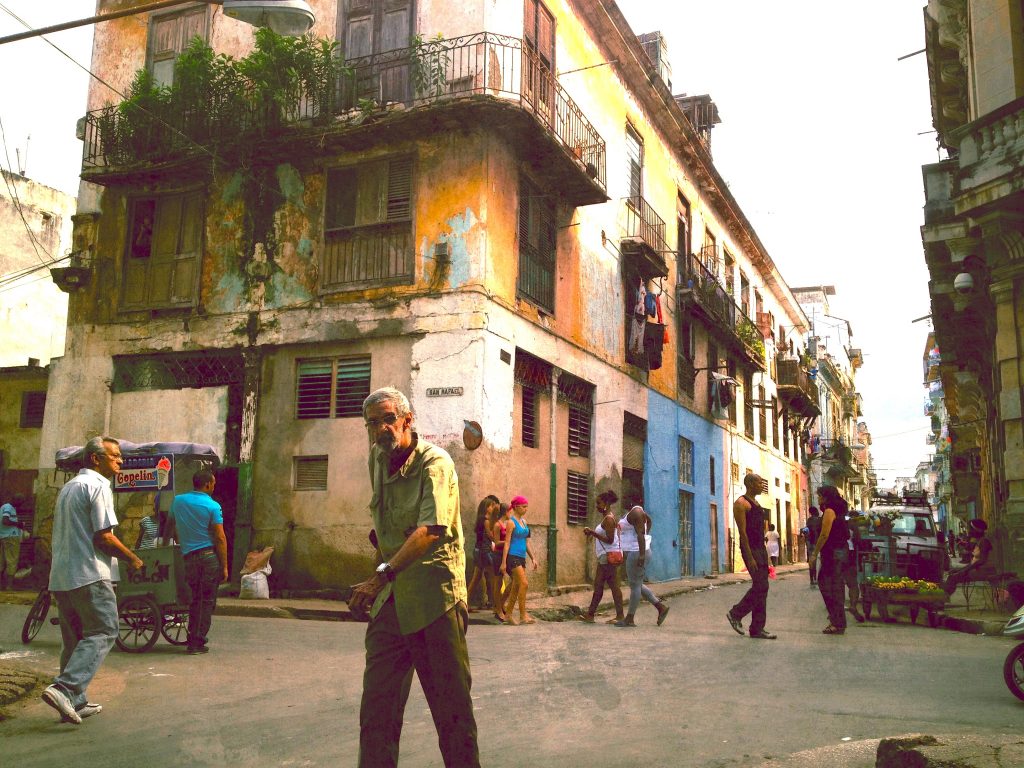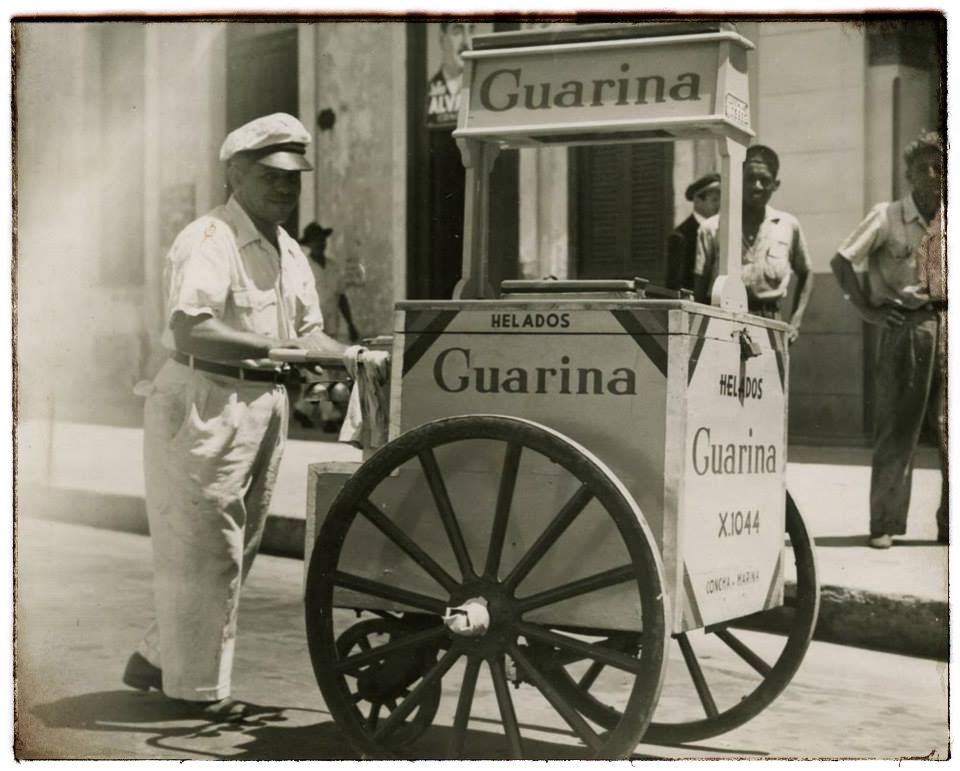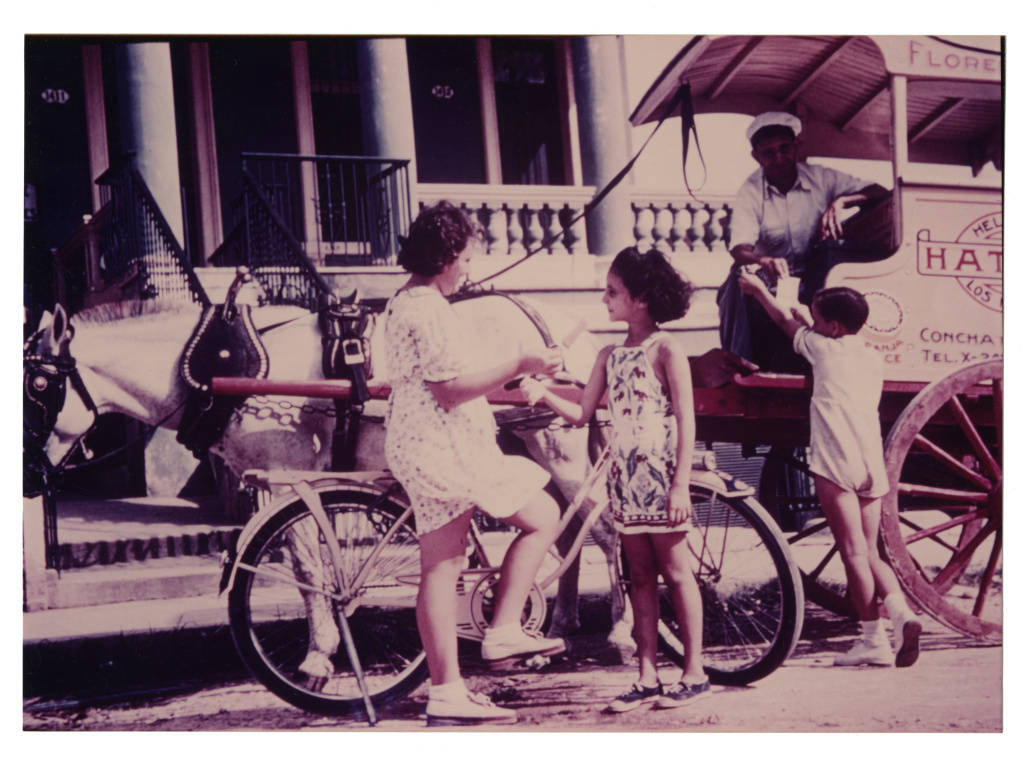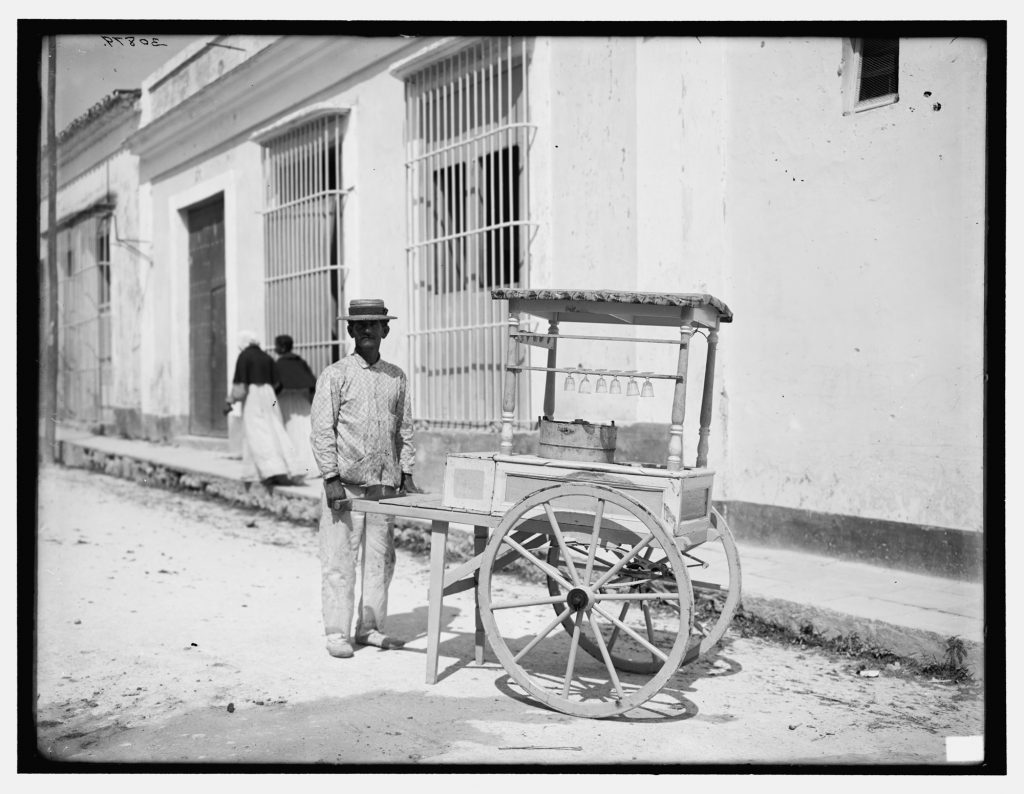Creative: Street Food Vendors
Vincent Andrisani
Artist’s Statement
“The Sweetest Sound in the City” is an audio documentary that tells a history of Havana through the sounds of the ice cream vendor. The piece comes out of a larger project on sound and listening in the city, developed using a combination of methods grounded in sensory ethnography and media archiving. Using a handheld audio recorder, and with the guidance of Havana-based oral historian Dr. Aurelio Francos Lauredo, I constructed a sound archive of Havana that today is housed at Fundación Fernando Ortiz. This audio documentary makes use of a number of those recordings, including the sounds of street vendors and Havana’s soundscapes among others. The narrative it tells was developed through my own research and is a story that (re)centres Havana as a city defined not by colonial or imperial rule, but one that belongs to the residents themselves.
Listen to the documentary. (See transcript below.)
The song “Helado Sobre Ruedas” by Gema y Pavel can be heard in the documentary and was used with permission from Peermusic Spain and Pavel Urquiza Domenech. [1]
- Figure 1: Havana’s ice cream vendor today, 2012. (image: author)
- Figure 2: The Guarina vendor on the streets of Havana, 1946. (image: www.havanacollectibles.com; photographer unknown)
- Figure 3: The Hatuey vendor on the streets of Havana, date unknown. (image: courtesy of the University of Miami Libraries, Cuban Heritage Collection)
- Figure 4: Ice cream vendor on the streets of Havana, 1890-1910. (image: archived in digital format at the Library of Congress Archives in the Prints and Photographs Division)
Exercises
Exercise 1: Listening to an Image
Have a close look at the photograph of the old ice cream vendor. Take a moment, study the image. Imagine you’re a resident living in Havana at the time. How might you have learned about the presence of the vendor? What are some of the sounds that he may have made? What are some other sounds that are in some way associated with him and his truck?
Exercise 2: Finding Sounds
This is a simple listening exercise, but it often produces surprising results. Whether you’re alone or in a group, take out a stopwatch or open your smartphone’s timer app. Take out a pen or pencil, and a piece of scrap paper, and be ready to use them. From the moment you press ‘go’ on your stopwatch, sit in silence and write down all the sounds you hear over the course of three minutes.
Some people’s lists will be longer than others, and that’s totally fine. All answers will be correct. This exercise highlights how differently each of us listen, because listening is a very personal practice.
Exercise 3: Categorizing Sounds
Now you’re going to work with your list from Exercise 2, categorizing each of the sounds you wrote down. Beside each sound, indicate its type using the letters N, H, or T, which stand for Natural, Human, and Technology (i.e., a machine-generated sound). Which of the categories is dominant?
Exercise 4: Listening to, and for, food sounds
A “food sound” is any sound that is in some way related to food. Some food sounds are directly related to the preparation or consumption of food (e.g., frying or chewing). Others are less obvious and can be related to such processes as preservation or transportation.
Using the categories above (Nature, Human, Technology), think of a food sound that falls into each of the three categories.
* These listening exercises are adapted from R. Murray Schafer’s text “A Sound Education” (1992).
Transcript
Vincent Andrisani: The Sweetest Sound
[Vendor’s chant, sound of passing vehicles]
It’s unlikely you’ll encounter this sound on your own street, but chances are, you know what it is. It’s the sound of a street vendor calling out to nearby residents, letting them know they have material goods or food items for sale. This particular vendor happens to be selling cookies.
[Vendor’s chant, sound of passing vehicles and brief car horn]
In the city of Havana, Cuba, where this recording was captured, this sound can be heard at most times of the day. There, vendors walk the streets and capture the attention of residents using a signature musical cry known in Spanish as a “pregón.” Presumably, the more musical and captivating the pregón, the more successful the vendor is.
[Vendor chanting a pregón]
But there’s one vendor whose sounds you might very well hear on your own street. A vendor that doesn’t use a pregón, but instead, plays a recognizable musical jingle. A jingle that summons childhood nostalgia, and is symbolic of a tasty summertime treat.
[Recorded music plays over sound of passing cars, children’s voices, and birds chirping]
Of course, I’m talking about the ice cream vendor. The recording you’re listening to was captured on a street corner in the district of Central Havana, one of the older and more populated areas of the city. You might notice that the vendor’s not moving, and neither am I. We’re standing across from one another in the same intersection. And the vendor is standing next to his parked tricycle, waiting to greet customers.
[Vendor’s music, ringing of bicycle bell, voices and ambient street noise]
I thought this was a bit unusual at first since vendors are typically on the move, but after thinking about it for a while, I realized that he’s playing music, not only for people in the streets, but also, for people in their homes. Because there’s no glass on windows and doors are often left open, sounds move easily between the street and the home. This vendor knows that, and so stopping in a populated intersection is actually a pretty good sales tactic. When I let one of my friends listen to this recording, he said, “You know, this is a very new sound in our city.” I replied, “How could this be a new sound? Ice cream vendors have been around for a really long time.” He said, “of course they have. But in Cuba, they were silent for many years.”
[Vendor’s music fades to silence]
In 1990, the fall of the Soviet Union brought about an intense economic crisis in Cuba. Over the next several years, there was barely enough food to eat, let alone ingredients to make ice cream. Only in about 2010 did the sound return. And today, ice cream vendors can be spotted ‘most anywhere in the city and at ‘most, any time of the year.
[Lively Cuban music begins, with whistling and a woman singing in Spanish]
Because of this, I realized that there’s a profound difference between how I listen to this sound, and how it’s heard by residents of Havana. For them, it must have a very different meaning since it was gone for over two decades. And one way we can hear that meaning is in song. This song by Havana-based duo Gema y Pavel, is called “Helado sobre ruedas,” which means “ice cream on wheels.” It’s a musical tribute to Havana’s missing ice cream vendors, and it represents them as a source of joy, happiness, and as a neighborhood event that, as the song says, “made family problems disappear.”
[“Helado sobre ruedas” plays]
So, I wondered, how can I listen to the sounds of the ice cream vendor in a way that resembles how residents of Havana listen to it? And what place does this sound hold in the collective memory of the city? To answer these questions, I’d have to follow the sound through history. I’d have to learn how it sounded before it was silenced, all the way back to the moment that it appeared on the streets of Havana. So that’s what I did.
[“Helado sobre ruedas” fades to silence. Electronic music box begins to play]
The sounds of the electronic music box that we heard earlier have been used by ice cream vendors for quite some time. The technology was invented in the mid 1950s by Minnesota-based company Nichols Electronics. And so, these were the sounds that were heard on the streets of Havana before the vendor fell silent. They appeared sometime in the late 1950s and were present right up until about 1990 at the onset of the crisis.
[Music box continues playing]
But before this technology became available, ice cream vendors were associated with an entirely different set of sounds.
[Music box fades, bell starts ringing]
One of which was the bell, which vendors in the 1940s and 50s would ring as they walked the streets with a cart they pushed by hand. Some of them would pause from time to time to ring the bell, but others mounted it directly onto their cart so they could ring it as they walked. Another sound made by ice cream vendors was much less deliberate.
[Small bell ringing; sounds of horse-drawn carriage moving along street]
While some vendors walked the streets with pushcarts, others traveled with a horse and carriage. And so, you can imagine what the sounds associated with these vendors might have been. A memoir written by Iris Díaz, a former resident of Havana, offers a really rich description of her memories of the horse-drawn carriage. Díaz says the following, [female speaking voice] “I remember the hoof sounds of a horse pulling the Hatuey ice-cream cart, and the cries of a peddler ringing his bell, yelling ‘Helado!’ Children ran into the street, holding onto their nickels and dimes to buy that creamy vanilla ice cream cone, then balancing the cone in one hand as they tried petting the horse with the other. The sweetest sounds were the happy voices of children calling each other, ‘Angelina come out to play!'”
[Street noise and sounds of children playing]
And all of these sounds: the bells, the horse, the carriage and the children, could be heard just like the modern vendor in the streets and through open windows and doors into nearby homes. But we can go further still into the past and listen to the moment that ice cream vendors first appeared on the streets of Havana.
[Street noise fades to silence. Sound of a large crowd of people at a baseball game]
During Cuba’s struggle for independence in the late 1800s, cultural practices, traditions and customs from the United States began to replace those from Spain. For instance, baseball took the place of bullfighting and was an important example of the island’s turn-away from Spanish colonial culture in favor of a more modern American way of life.
[Murmur of crowd of people in baseball stadium, homerun, applause]
It’s no coincidence that streetside ice cream vending arrived in Havana at this very same time. And one way we know this is because an early ice cream vendor was captured in a photograph taken right around the time of Cuban independence in 1902.
[Camera light bulb flash, silence]
This photo tells us that early ice cream vendors also made use of a hand cart, but their cart was bigger and bulkier than those used in the 1950s. And it was made entirely of wood, so it was probably quite difficult for them to push. These vendors didn’t use sound-making technologies like chime music or bells. But that doesn’t mean they didn’t make any sounds.
[Creaking wooden cart wheels moving against ground]
The most obvious sound they’d make is their pregón. Presumably, they’d walk the streets shouting, “Helado!” Letting residents know they’re selling ice cream, just like vendors do today. These vendors marked an important moment and played an important role in the everyday life of the city for a couple of reasons. The first of which is that they offered the opportunity for the working class to purchase a food item that was historically reserved for the upper class. Through the ice cream vendor, ice cream became a popular confection that could finally be served to everyone. And the second reason, is that ice cream vendors represented the local desire to replace Spanish with American culture in the hopes of modernizing the island, and ultimately, demonstrating what it means to be Cuban. The sounds of the ice cream vendor were literally the sounds of a city and a cultural identity being formed!
[After the silence begins, the sound of wooden cart fades. “Helado Sobre Ruedas” begins to play again]
And it’s worth noting that this identity was brought to life, in part, using an ingredient that had grown in Cuba for hundreds of years: sugar! Sugar was the reason for the colony, and it plays an important role in the Cuban diet—which of course includes a steady dose of ice cream to keep cool on those hot Havana days.
It’s quite amazing to think that all of this information, and all of this history is expressed in the sound of the ice cream vendor. In it, we hear: the silence of Cuba’s economic crisis; Havana’s golden era in the 1940s and 50s, the Americanization of the city at the turn of the century, and the emergence of a middle class that could afford ice cream for the first time.
But in order to hear this, we not only had to listen to the sound locally, through the open windows and doors of Havana’s neighbourhoods. But we also had to listen globally, by mapping those sounds onto far away places at different moments in history: the Soviet Union in the late 1980s, Minnesota in the 1950s, and Spain in the late 1800s.
All of this history is expressed in the sound of Havana’s ice cream vendor today, but it takes a bit of time, effort, and guidance in order to hear it. It takes curiosity to map the linkages between taste, sound, people, their geography, and their history. But when we do, it enriches our experience. It makes the world make a bit more sense, once we accept the idea that certain sounds and certain flavours have a cultural history, and are defined not by one but by many different meanings.
So this raises the following question: what do you hear when you listen to the sounds of the ice cream vendor?
[Music fades]
- Song: Helado Sobre Ruedas Author: Pavel Urquiza Domenech © Peermusic Española, S.A.U. ↵





